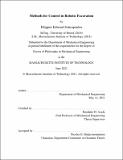Methods for Control in Robotic Excavation
Author(s)
Sotiropoulos, Filippos Edward
DownloadThesis PDF (7.357Mb)
Advisor
Asada, Haruhiko H.
Terms of use
Metadata
Show full item recordAbstract
Robotic excavation has been proposed as a means to meet the ever growing demand for skilled excavator operators in the construction, infrastructure, mining and agriculture industries. The development of fully autonomous excavation systems is hindered by inadequate methods to deal with the interaction between the machine and soil. The dynamics arising from the bucket-earth interaction, present a unique challenge from the robotics perspective. Not only is the behaviour of earth and fragmented rock highly nonlinear and distributed but also the terrain profiles and properties of excavation sites are uncertain, unstructured, and non-uniform. In this thesis new methods are presented and tested to tackle the current limits in robotic excavation arising from terramechanics modeling.
In particular, methods are presented to tackle the soil interaction problem in the context of three tasks typically encountered in robotic excavation. Firstly, we address the efficient bulk removal of material by introducing an approach that adapts for unknown and varying soil properties. Unlike traditional force control or trajectory control, the method uses the power transmitted from the excavator to the soil as a signal for adaptive excavation. Using an extremum-seeking algorithm, an optimal excavation depth that maximizes the output power of the machine is sought.
Secondly we tackle terrain shaping, where the objective is creating a final desired site shape. Here, more precise control of the bucket trajectory is required and a model-based approach is presented. Based on a novel form of lifting linearization termed Dual-Faceted Linearization (DFL), where a nonlinear dynamical system is cast into a higher dimensional space where its dynamics are more linear, a model for the bucket-earth interactions is obtained from data and utilized for effective path following control.
Finally, the problem of gathering larger monolithic rocks mixed with loose material is addressed. By training a Gaussian Process model the motion of a rock arising from its interactions with the bucket and surrounding material is modeled. Leveraging this model, and online estimation, we are able to reliably collect rocks of varying geometry.
Date issued
2021-06Department
Massachusetts Institute of Technology. Department of Mechanical EngineeringPublisher
Massachusetts Institute of Technology